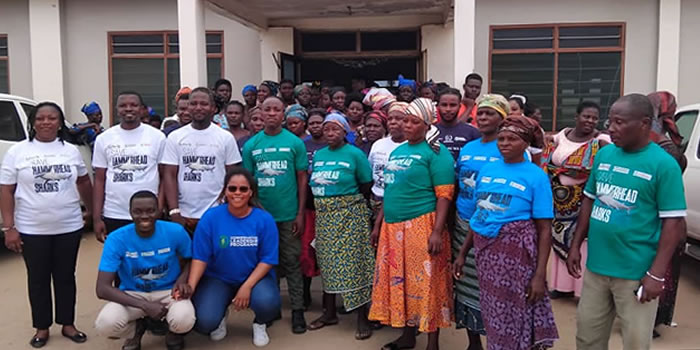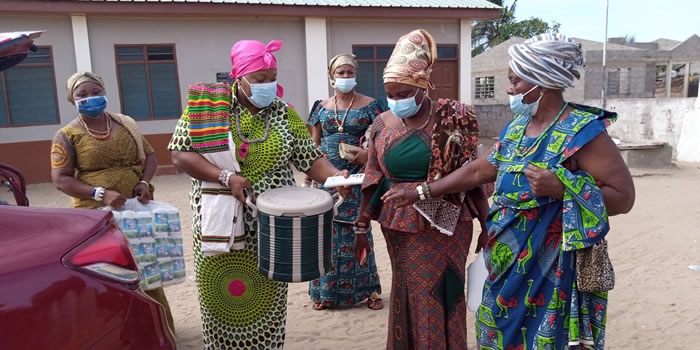

Health
The provision of a complete state of physical, mental and social well-being without merely focusing on the absence of a disease or infirmity is an invaluable prerequisite for economic growth. Health and development are related and inseparable in every economy. Most often, there are several factors which affect health: poverty, education levels, food intake, employment, access to clean water and sanitation and housing conditions through to personal practices such as sexual behaviour or smoking.
All these factors are indices of development and have positive or negative correlation effect on health. All these dimensions have therefore emphasized a multi-sectoral approach as well as multiagency collaboration towards health and the provision of health care. Over the years, the district has made considerable strives to improve the health conditions of the general populace.
This fulfilment became highly imperative following global efforts towards the attainment of the Millennium Development Goals. In 2000, the Dangme East District Hospital was constructed to augment the services of other health facilities in the district. However, it was discovered that the existing health facilities have fallen short of the demands of the populace particularly because; population is sparsely distributed in the district.
Following this, the district has made strenuous efforts to construct health centres and CHPS compounds in communities which find it difficult to access the clinics as well as the District Hospital due to either physical accessibility or the cost implications involved with respect to their locations. What has become a major challenge for the district is the inability to provide accommodation for the health personnel posted to the district. This has made the retention of staff in rural areas very difficult, since the district does not have the capacity to contain them.
Health Insurance
In recent years, there has been a sharp increase of interest in the issues of how the health sector should be financed. This increasing realization and participation became necessary following the dilemma of scare resources. For many proponents, financing health care is heavily dependent on tax revenues and social insurance.
However, there are a number of factors which governments are considering and for that matter may want to secure alternative funding mechanisms for the health sector. The introduction of user charges by the World Bank has lingered in Ghana for some time and has been seen as an obstacle to securing health care particularly because they are usually not in the capacity to pay charges.
In view of all these complexities, the National Health Scheme was adopted and spread as a social intervention which will bring relief to the general populace in attempts to secure health care. In the Ada East District, a total of 125,759 clients are covered by health insurance. Table 1.27 below presents the categories of Health Insurance Clients in the District.
Figure 12 shows the graphical view of the total number of clients under the Insurance Scheme. From the diagram, it can be observed that, the proportion of the Under 18 years dominate, with a % of 88 of the total insured from the period of 2006-2009.
Despite the fact that, a large number of people have been covered under the insurance scheme a widening gap still exist particularly between the categories of Age over 70.
The number of registered clients under this is not encouraging. With respect to the 2000 population age cohort, the existing number of people age over 70 was extremely higher than the registered number under the insurance scheme. What is identical about this category however, is the fact that most of them do not have the capacity or the strength to secure health insurance.
It is therefore imperative to intensify education in solicitation of support for the aged population. It is also crucial for the District to secure the insurance policy for those who are not in the capacity to do so. Last year, a total of 1,000 aged have been selected to benefit from the policy. The process will be reviewed and roll on to the 2010-2013 development year.
The diagram above presents the view that, under 18 years dominate. The underlining challenge however, is that, a large number of the Under 18 which reported at the various health facilities in the district are still contending with the inability to secure a health insurance. Table 1.28 below presents the analysis of the counted insured and non-insured at the various health facilities in the district.
Table 33 and 34 has presented a serious issue of concern. Records on 2007 and 2009 OPD indicate that, there is a strict gap despite the large of Under 18 years covered by the Health Insurance Policy. In both periods, the non-insured dominated the insured. This is not a challenge to the district only, but, also indicates a serious backlog in efforts towards meeting the Millennium Development Goals. The district is basically rural, it is therefore important to intensify awareness programmes in rural areas. It has been discovered that, the inability of some pregnant women to secure the policy is serving as pander to Antenatal and Postnatal attendance. This, if allowed could worsen the Maternal and Infant Mortality ratio of the District.
The table above presents the Top Ten Diseases in the District. From the table, it can be deduced that, Malaria is top-ranking averaging over 50 percent of the all the top ten diseases. This year alone, Malaria has caused about 11 deaths. The District is intensifying campaigns against the prevention of Malaria yet, it keeps on compounding.
From the table above, it was only the 2009 period that did record any increase over the previous figure. There is the need to expedite action on the construction of CHPs Compound in the District. This will decentralize health care measures and emphasized more preventive than curative measures to reduce the communicable and non-communicable diseases in the District.
According to the District Health Report, 2009, the increase in Malaria cases was due to the failure to attend non-laboratory Malaria diagnosis. It has therefore been recommended that, there is need to intensify health promotion activities in connection with the use of ITN’s and Antenatal care. The District Hospital recorded over 1,406 eye cases in 2007. Common among the problems include: Trichiasis, Ptosis, Corneal Ulcer, Kerattis style, Chelazon entrepion, Coeneal foreign etc. It has been detected that, refractive errors among the elderly are the common visual acuity. There is the need to support the unit with the needed logistics and encourage those with the visual problems to secure proper lenses to support their vision.
The table below indicates the top ten diseases that cause death in the District. HIV/AIDS is top-ranking with a high percentage of 39 for the period of 2009. Hypertension and Malaria have claimed the lives of 31 persons within the period. Assuming this trend moves in the continuum, a recorded death of 207 will occur as a result of the three diseases by 2013. It is quite mind-boggling particularly, with HIV/AIDS.
Besides all the programmes juxtaposed to the radio announcement and testing and counselling sections in the hospitals, the disease is still on the ascendancy. Currently, a prevalence rate of 3.2 per cent has been record by the Sentinel Survey on HIV/AIDS of Dangme East District conducted by Ghana AIDS Commission. Table 1.33 below presents the breakdown of the causes of death in the District.
Expanded Programme on Immunization
In 2015, a target of 7,426 children under 11 months was determined to be covered by the immunization programme. The output assessment report however, indicated that, the covered of the programme fell short of this target. However, it can be said that, apart from Measles and Yellow fever which recorded minimal improvement, significant improvements saw a continues decline in BCG, OPV 3 and Penta 3 from 2014.
The reasons for the poor performance in the above stated diseases were due to inadequate staff and inadequate transportation facilities compounded by frequent breakdowns in vehicles. Table 1.34 below presents the coverage of the District in 2016.
HIV/AIDS
Gradually, the issue of HIV/AIDS has crept into the District Economy. According to a report by the Ghana AIDS Commission, the prevalence rate of HIV/AIDS in Ghana as of 2000 was 3 per cent and there were about 230,000 adults and 20,000 children suffering the diseases. In that same year, the prevalence rate of the Dangme East District was said to hovering at 3.5 per cent - about 0.5 per cent higher than the national rate and which is also lower than the prevalence rate for the North Tongu District by 0.2 according to the Sentinel Survey by the AIDS Commission.
The issue of HIV/AIDS is alarming and it is about time the district took a more pragmatic effort towards a reduction in the spread. Among the top ten diseases that cause death in the District (Table 1.33 above), HIV/AIDS alone had claimed the life of over 38, representing 39 per cent of the total causes.
In 2009, the district registered 4,692 pregnant women against 4,692 in 2008, an increase of 5.98 per cent. Out of the 4,692 pregnant women, 99.7 per cent were tested, and 73 (representing 1.46 per cent) remained positive. Again, HIV/AIDS awareness programmes through Counselling and Testing, Know Your Status, PMTCT (Prevention of Mother to Child Test), and Tuberculosis and HIV collaboration revealed 522 persons as caring the HIV/AIDS virus in the District.
The above analysis indicates that, a grievous situation has befallen the district and without more pragmatic approach the situation will go out of hand and the district will lose its labour force through the disease.
A concerted effort through the participation of Civil Society Organizations; Non-Governmental Organizations; Community Based Groups and Association of the Physically Challenged and the Visually Impaired; Women Associations; Traditional Leaders, Elders and Queen Mothers are needed to find appropriate remedies to the situation.
Already the district has pledged its commitment to the process through the creation of an HIV/AIDS Desk, a Focal Person and the statutory allocation of 0.5 per cent of the Common Fund to HIV/AIDS Programmes. A total of 4 HIV/AIDS Centres have been created in the District. They included: Kasseh, Ada, Pediatorkope Health Centre and District Hospital which also the Treatment Centre.
Challenges of the Health Sector
Over the years, a wide range of challenges have confronted the health sector. Key among these challenges includes the issues of:
1. Inadequate accommodation for Health Workers
2. More Laboratories for other facilities in the District
3. Intensification of Health programmes on Radio Ada and logistics to sensitize and train additional chemical sellers and traditional practitioners on awareness of TB/HIV
4. The needed logistics to intensify monitoring and supervision to all treatment centres.
5. Infrastructure for permanent CHPS Compounds.
Date Created : 11/15/2017 7:32:07 AM












 facebook
facebook
 twitter
twitter
 Youtube
Youtube
 +233 593 831 280
+233 593 831 280 0800 430 430
0800 430 430 GPS: GE-231-4383
GPS: GE-231-4383 info@ghanadistricts.com
info@ghanadistricts.com Box GP1044, Accra, Ghana
Box GP1044, Accra, Ghana